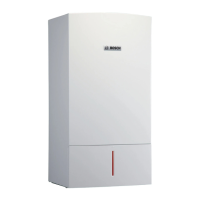38 | Installation
Copyright (optional information)6 720 643 068 (2011/06)
5.3 ZBR..-3A appliances (heating boilers):
Selecting an expansion vessel
External expansion vessel
B Determine size of the expansion vessel.
Fig. 11 Sample installation - expansion vessel
5.4 Selecting the installation location
Installation location requirements
Observe the current national and local codes and
regulations.
B Observe country-specific requirements.
B Observe installation instructions of the venting system
accessories and their clearances.
Combustion air
To avoid corrosion, keep the supply of combustion air free
of corrosive substances; contained in solvents, paints,
adhesives, propellants and domestic cleaning agents.
Surface temperature
The max. surface temperature of this appliance is below
185 °F (85 °C). According to ANSI/Z223.1/NFPA43
(National fuel gas code) and CAN/DAS B 149.1 (Natural
Gas and Propane installation code), the appliance is
approved for zero clearance to combustibles. For servicing
a clearance of 4" (102 mm) is recommended.
6 720 641 933-20.1O
Industrial sources
Chemical cleaning Trichloroethylene, tetrachloroethyl-
ene, fluorinated hydrocarbons
Degreasing bath Perchloroethylene, trichloroethylene,
methylchloroform
Printing shops Trichloroethylene
Hair salons Aerosol propellants, hydrocarbons
containing fluorine and chlorine (diflu-
orodichloromethane)
Household sources
Cleaning and
degreasing agents
Perchloroethylene, methylchloroform,
trichloroethylene, methylene chloride,
carbon tetrachloride, hydrochloric acid
Workshop
Solvents and thin-
ners
Various chlorinated hydrocarbons
Aerosols Chlorofluorinated hydrocarbons (diflu-
orodichloromethane)
Tab. 17 Corrosive materials

